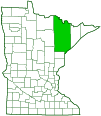California jumping gall wasp
(Neuroterus saltatorius)
Conservation • Description • Habitat • Ecology • Distribution • Taxonomy
Conservation Status |
|
|||||||
| IUCN Red List | not listed |
|||||||
| NatureServe | not listed |
|||||||
| Minnesota | not listed |
|||||||
Description |
||
California jumping gall wasp also called simply jumping gall wasp, is a very small cynipid wasp. It is native to western United States including the states of California, Oregon, Washington, and west Texas. It has spread north into British Columbia. It has been reported in several eastern states, where it is believed to have been introduced, including Missouri, Michigan, Indiana, Kentucky, Minnesota, Iowa, and Wisconsin. It was reported in Minnesota in 2000. It is still uncommon in the state, but where it appears it may do so in large numbers. It produces abnormal growths (galls) on the leaves of trees in the white oak group. In Minnesota, this includes white oak, swamp white oak, and bur oak. The adult wasp is very small, 1⁄32″ (0.75 mm) long. It appears hump-backed. The head is brownish-black. The antennae have 13 segments. The thorax is brown, the abdomen black, the legs reddish-brown, and the wings clear. It is not possible to identify adults in the field due to their small size and similarity to numerous other species. Cynipid wasps are best identified by the galls they produce. Galls appear on the underside of a leaf in early spring. They mature before the leaves are fully grown. A single leaf may have hundreds or even thousands of galls. Each gall is spherical, white, and 1⁄32″ (1.0 mm) in diameter. |
||
Size |
||
Total length: 1⁄32″ (0.75 mm) |
||
Similar Species |
||
Habitat |
||
White oak, swamp white oak, and bur oak |
||
Ecology |
||
Season |
||
Two generations per year: March and mid-April to mid-May |
||
Behavior |
||
It does not sting. |
||
Life Cycle |
||
Asexual female adults emerge in March. They lay eggs on the underside of host plant leaves. Sexual male and female adults emerge from mid-April to mid-May. Second generation galls drop to the ground in June. They jump up to an inch high due to movement of the larvae inside. They continue to jump around “for some time.” The larva pupates in the fall and overwinters in the gall. |
||
Larva Hosts |
||
White oak, swamp white oak, and bur oak |
||
Adult Food |
||
Adult wasps do not feed. |
||
Distribution |
||||
|
Sources Minnesota Forest Health Annual Report - 2000. |
|||
| 6/24/2023 | ||||
Occurrence |
||||
Uncommon in Minnesota |
||||
Taxonomy |
|||
Order |
Hymenoptera (Ants, Bees, Wasps, and Sawflies) | ||
Suborder |
Apocrita (narrow-waisted wasps, ants, and bees) | ||
| Infraorder | Proctotrupomorpha | ||
Superfamily |
Cynipoidea (gall wasps) | ||
Family |
Cynipidae (gall wasps) | ||
Subfamily |
Cynipinae | ||
| Tribe | Cynipini (oak gall wasps) | ||
Genus |
Neuroterus | ||
This species was formerly named Cynips saltatorius. |
|||
Synonyms |
|||
Cynips saltatorius |
|||
Common Names |
|||
California jumping gall wasp jumping oak gall |
|||
Glossary
Gall
An abnormal growth on a plant produced in response to an insect larva, mite, bacteria, or fungus.
visitor Photos |
|||||
Share your photo of this insect. |
|||||
| This button not working for you? Simply email us at info@MinnesotaSeasons.com. Attach one or more photos and, if you like, a caption. |
|||||
|
|||||
MinnesotaSeasons.com Photos |
|||||
|
|||||

Slideshows |
||

visitor videos |
|||
Share your video of this insect. |
|||
| This button not working for you? Simply email us at info@MinnesotaSeasons.com. Attach a video, a YouTube link, or a cloud storage link. |
|||
Other videos |
|||
| Jumping Oak Gall (Cynipidae: Neuroterus saltatorius) on Oak Leaf Carl Barrentine |
|||
About
Jun 17, 2011 This leaf gall results from the larvae of a Cynipid Gall Wasp (Neuroterus saltatorius). Photographed at Fisher, Minnesota (17 June 2011). |
|||
| The Jumping Gall Wasp (scientific name: Neuroterus Saltatorius Edwards) William Pedersen |
|||
About
Jul 22, 2020 Each gall contains a single wasp larva that feeds on the inner lining of the gall. The galls drop to the ground when they have matured. The activity of the larva inside the gall actually makes the gall jump around on the ground after they have fallen from the tree. The insect overwinters inside the gall. In the spring, the females emerge and lay their eggs in newly opened leaf buds. The galls form in response to chemicals in the larva’s saliva. The galls only form on species of white oak. |
|||

visitor Sightings |
|||||
Report a sighting of this insect. |
|||||
| This button not working for you? Simply email us at info@MinnesotaSeasons.com. Be sure to include a location. |
|||||
| Mandy 6/23/2023 |
Location or County: Bowlus, MN, Morrison County |
||||
MinnesotaSeasons.com Sightings |
|||||
|
|||||

Created: 8/29/2020
Last Updated:
